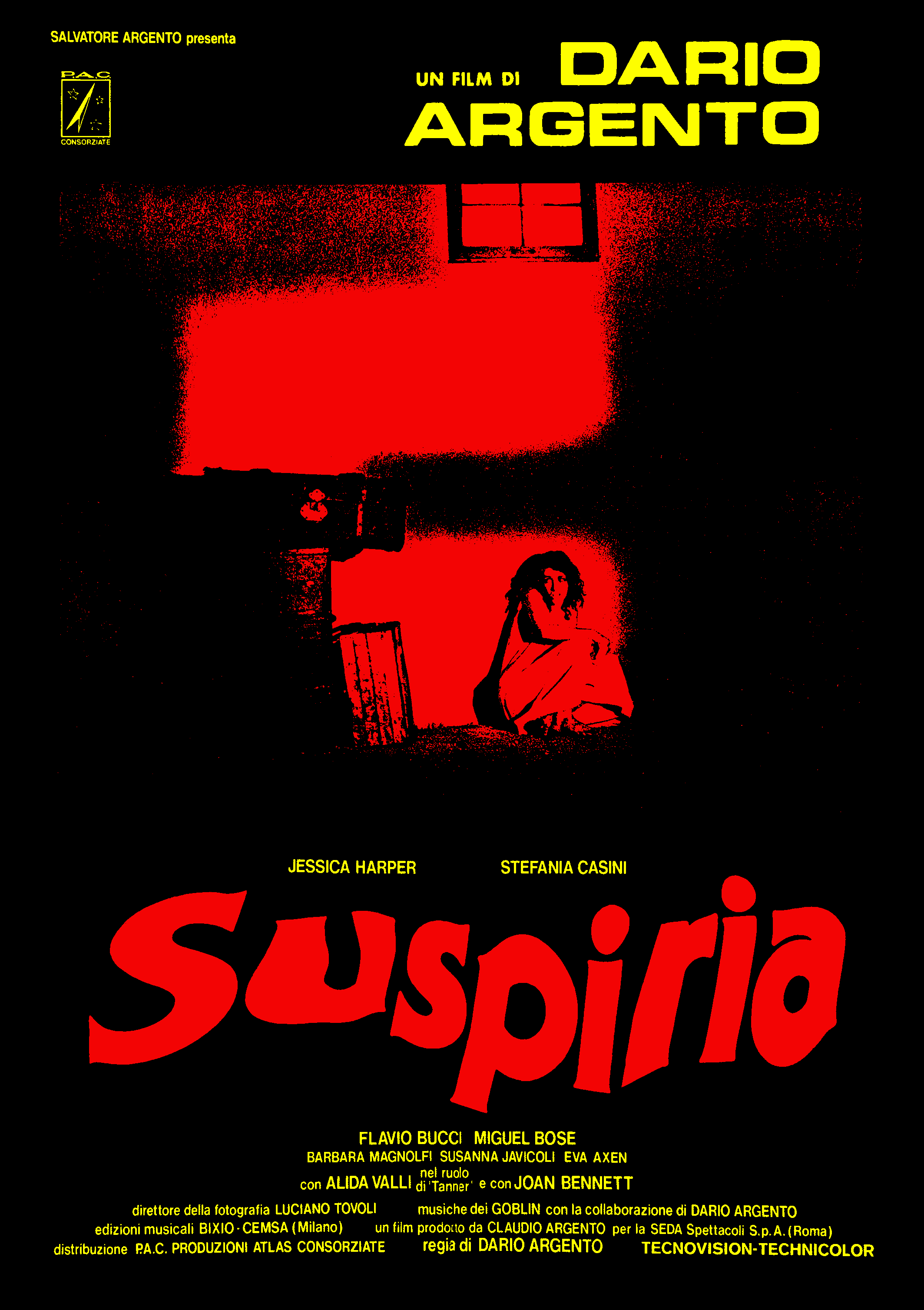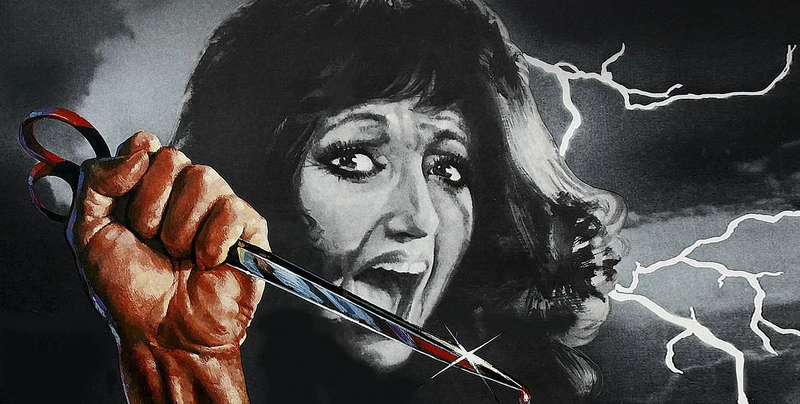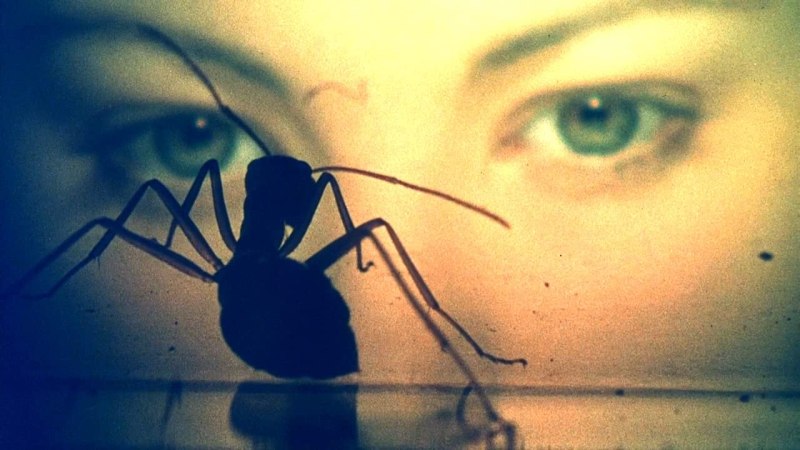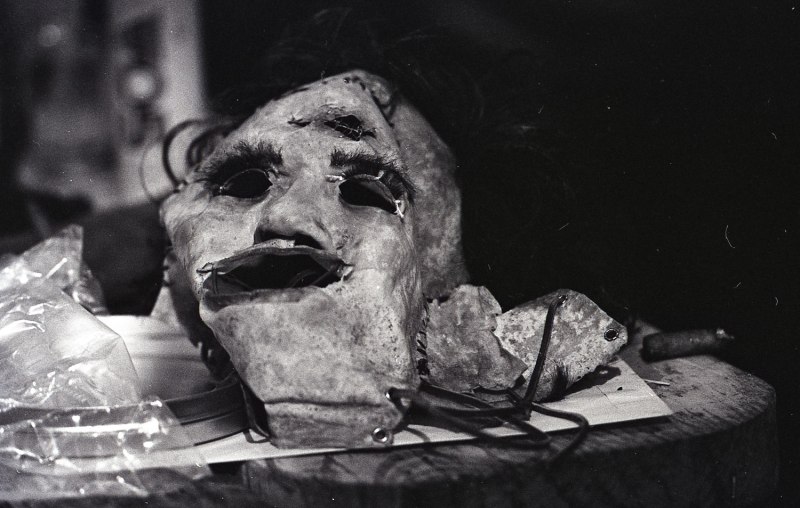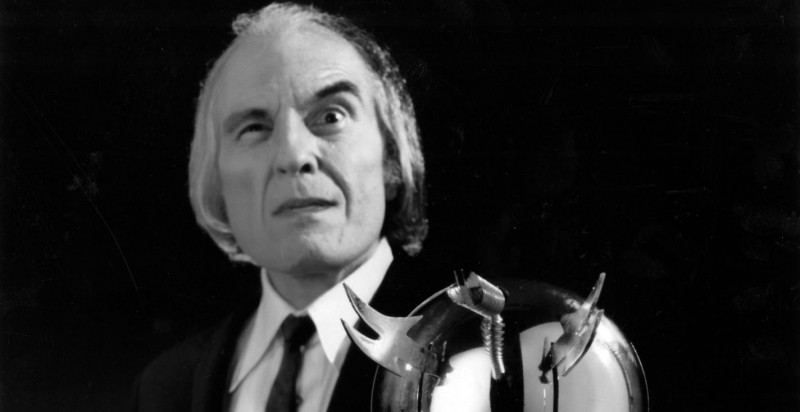
Dario Argento’s masterclass in visceral terror is still one of the most unique experiences that horror has to offer
‘The only thing more terrifying than the last 12 minutes of this film are the first 92,’ proclaims the theatrical poster for Dario Argento’s Suspiria, a vivid, almost garish representation of primal fear right out of the freaky, gore-embracing 70s. ‘Once you see it you will never again feel safe in the dark’.
In reality, Suspiria, an occult tale that arrived in the midst of a cultural obsession with Satanism and evangelical fear, is a delirious explosion of fever-inducing colour that is best experienced in the dark, but as hyperbolic as the poster’s tagline is, it was, and still is an accurate description of a film that’s positively alive with fear of the most sensorial variety. “People came running out, screaming, telling people in the queue ‘Don’t go in! Don’t go in! It’s all witches!'” Argento would recall, describing the moment he was sitting in his car during the film’s opening night, a stampede of terrified viewers fleeing a nearby theatre in a blind frenzy. “It just made everyone in line want to get in even more… it was amazing.”
Years later and some view Argento’s most celebrated work an an exercise in style over substance. It’s plenty stylish, and if you’re looking for a conventional cinema experience it’s certainly lacking substance. The plot is sketchy, can feel almost peripheral at times. The characterisation is weak, the acting generally sub-par. In fact, much of what we experience is erratic and illogical, but to truly appreciate Suspiria you have to be willing to sacrifice logic. You’re not going to find complex characters, Oscar-winning performances or emotionally affecting narrative developments. Italian horror had a reputation for being somewhat rough around the edges, but few movies benefit like Suspiria, which exits the stalls like a galloping unicorn forged from an exploding rainbow. You may feel lost, confused, completely disorientated, but that’s precisely the point. Suspiria deals with supernatural themes with a surreal, feverish flourish, eschewing traditional logic for pure, visceral terror. Above all else, it’s a movie that we experience.
Goblin’s frantic intro, exploding against an ambiguous black and white screen, sets the tone for that disorientation, the film’s initial location acting as a gateway to the sorcerous wonderland that awaits protagonist Suzy Bannion’s arrival in Freiburg, Germany. Suzy is a young American dance student on her way to the world-renown Tanz Dance Akademie, a respected institution with a rather macabre secret that opens a Pandora’s Box of pure sensation. That opening scene, filmed on location at Munich airport, is one of only two that are shot using a natural palette, the other being Suzy’s visit to the convention centre, the place where she learns about the school’s founder, Helena Marcos, a maleficent who uses the prestigious academy as a front for her centuries-old coven. Those naturalistic scenes are the only instances that convey a sense of normality. The first is a brief prelude to a waiting evil, the second providing the only substantial interaction in the entire movie, a traditional scene which dissolves as soon as Suzy returns to her lodgings. Other than that, turn out the lights, crank up the audio, and yield to Suspiria‘s hypnotic spell. It’s one of the purest expulsions of horror you’re ever likely to experience.

Suspiria was something of a departure for Argento. After a brief career as a film critic and screenwriter, working on Sergio Leone’s classic spaghetti western Once Upon a Time in the West before finding his feet in the world of horror, he would follow in the traditions of giallo innovator Mario Bava, his directorial debut L’uccello Dalle Piume di Cristallo (The Girl With the Crystal Plumage) wowing the Italian box office and earning plaudits internationally. Thanks to the impositions of fascism and the Vatican, Italy didn’t produce a single recognised horror movie until well after Hollywood’s golden age, Riccardo Freda’s I vampiri (1957), a Bava co-production, opening doors for a new generation of innovators. Drawing comparisons with the great Alfred Hitchcock and earning himself the moniker ‘Master of the Thrill’, Argento’s giallo output would peak with 1975’s Profondo Rosso (Deep Red), a genre high-point that set him on a supernatural path. By that juncture, Argento felt he had gone as far as he could with the lavishly violent whodunnits he’d helped to perfect. The genre had already fallen into reductive rip-off territory, leading him to explore other creative avenues, and explore them he did.
Suzy, do you know anything about . . . witches?
Sara
The main influence for the director’s astonishing stylistic digression came in the form of a collection of psychological essays entitled Suspiria de Profundis, which examined the concept of ‘Our Ladies of Sorrow’, manifestations that author Thomas De Quincey would use to personify, “the mighty abstractions that incarnate themselves in all individual sufferings of man’s heart.” Those manifestations would become the focal point of Argento’s ‘Three Mothers’ trilogy, beginning with Suspiria and continuing with 1980’s equally beguiling Inferno and 2007’s The Mother of Tears. Inferno‘s prologue, a passage that deviates from De Quincey’s source material, describes Suspiria‘s Mater Suspiriorum aka The Mother of Sighs as the oldest and wisest of the three mothers, who along with Mater Lachrymarum (the Mother of Tears) and Mater Tenebrarum (the Mother of Darkness), use their powers to manipulate world events from their bases in Rome (Lachrymarum), New York City (Tenebrarum), and in the case of Mater Suspiriorum, Freiburg, Germany. Dubbed Helena Marcos by Argento, the ancient Mater Suspiriorum’s powers have begun to fade, but they’re still potent enough to draw Suzy into a kaleidoscopic realm that throbs with insidious beauty.
Suzy is one of the genre’s iconic heroines, a character who wanders through a wicked wonderland with the infallible innocence of a spellbound deity. There’s a sense of naivety about her that for some proves borderline-infuriating, but the innocence of her actions, her destiny as queerly inevitable as the fabled events of a pop-up picture book, are just as endearing, a beacon of light in a sea of inescapable treachery. Though Suzy’s seeming unwillingness to identify danger in an odyssey that begins as soon as she arrives in Germany was at least in part accidental, it works beautifully, only adding to the movie’s fantastical aura. Argento initially planned to use children as young as twelve as the ballet school’s doomed inhabitants, an idea he was forced to renege on after heeding the warnings of producer and father Salvatore, who wisely predicted that having children in such a violent picture would provoke the wrath of censorship and likely lead to an all-out ban. Though turning to adult actresses, Argento neglected to rewrite the screenplay, which explains the often puerile dialogue and general immaturity of the film’s characters, who mock and taunt each other with the facile abandon of a group of pre-schoolers.

This may have posed a problem for a more traditional movie. When characters, dialogue and narrative are front and centre, you tend to notice such aberrations, but with Suspiria it proves yet another idiosyncrasy that further embellishes Argento’s visual and audio enigma. Even the set was designed to accommodate girls of a pre-adult stature, but the movie remains a unique experience that almost invites such irregularities, which in fact thrives on them. “The financiers and distributors got scared and said audiences don’t want to see children murdered on screen,” Argento would recall. “But I kept many elements in the film that were conceived for a cast of children: the dialogue didn’t really change, only a few parts were updated; and small elements remained to give a child’s perspective, like the door handles in the school are positioned high up. These things helped keep an atmosphere of innocence and purity.”
It’s this innocence and purity that sets the tone for the macabre fantasy that transpires. Suspiria‘s every set-piece is a theatrical descent into the unreal. The movie might best be described as a nightmare fairy tale, is influenced as much by early 20th century expressionist cinema (The Cabinet of Dr Caligari) as it is by the likes of Alice in Wonderland, a tale that co-screenwriter Daria Nicolodi, Argento’s girlfriend at the time, had in mind from the beginning. Technically, the director’s opus was inspired by an autobiographical story told to Nicoldi, whose grandmother had fled a similar situation upon discovering that her music school was run by staff who were heavily into black magic and the occult, subjects that go hand-in-hand with such fantastical tales. Even more of an aesthetic influence was Disney’s Snow White and the Seven Dwarfs, an animated classic with outlandish colour palettes and creepy aesthetics.“[In] Suspiria … we were trying to reproduce the colour of Walt Disney’s Snow White,” Argento would explain. “It has been said from the beginning that Technicolor lacked subdued shades, was without nuances—like cut-out cartoons.”
Snow White, a lonely young princess ensnared by the magic of a wicked queen, was certainly the template for Suzy. In terms of colour, composition and general aesthetics, there are so many direct comparisons to be made. The Black Forest that a fellow student theatrically stumbles through draws immediate comparisons, as does the the way in which Suzy is shot, be it sleeping softly on a pillow, gazing tentatively through a window or sitting drenched in a taxi — all physical re-enactments of Snow White achieved through the use of colour and composition. In the film, Suzy is slowly poisoned in what is a direct nod to Disney’s poison apple. There are even visual comparisons to be made between the dance Academy’s coven and the wicked queen, who gleam with the same prestigious maleficence.
In order to lend Suspiria the authentic look of an old-fashioned fairy tale, Argento used imbibition Technicolor prints, the same process used to create the unique and queerly macabre aesthetics for 1939’s The Wizard of Oz, an inspired decision that makes the film such an unsettlingly surreal experience. “We wanted to recreate the colours of old Technicolor and Disney films,” Argento would say. “The vivid, strong colours in those films stayed in my memory from childhood. Amazingly, [cinematographer Luciano Tovoli] discovered some old Kodak stock in a lab in America and we used that. But there was such a limited amount, we only had enough to shoot one or two takes so we did a lot of rehearsals before each shot. That’s why Suspiria took so long to film: 16 weeks.”

All you have to do is look at the characters on show to see Suspiria‘s fairy tale influence. The cast are a circus grotesquery, from the militant Miss Tanner (Alida Valli) to the academy’s surreptitious mouthpiece, Madame Blanc (Joan Bennett) ― genial and helpful on the surface but prone to fits of rage and intently murderous when Suzy stumbles upon their secret hiding place. You also have a bearded entourage of witches keeping guard, a queerly docile butler reminiscent of Dr Frankenstein’s Igor, and a young boy who wouldn’t look out of place in The Omen. Even Suzy’s fellow dancers are sinister in their intentions, particularly the distinctly witch-like Olga (Barbara Magnolfi), who gleams with spiteful malevolence from the outset.
Then you have the elegant Suzy (Jessica Harper), the archetypal Disney princess with the rose petal skin, doe-eyed as she flutters like a fleet-footed Bambi caught in the headlights. It’s astonishing how redolent she is of her animated blueprint. Argento discovered Harper in Brian De Palma’s musical horror comedy Phantom of the Paradise and immediately fell for her Angelic façade, seeing her as the perfect visual anchor for a film that was researched extensively during a European road trip that led the director deep into Black Forest villages inhabited by practicing witches. Harper was the angelic antithesis, an emblem of purity to oppose the coven’s wickedness. “Jessica looked like a Manga character”, Argento would recall. “Big eyes and small features, she was so innocent looking, perfect for the role.”
Cinematographer Tovoli, who found Argento’s unusual expressionist approach to contemporary film both a challenge beyond his experience and a joy to embrace, experimenting with light in unique ways that made Suspiria the total abstraction from reality that the director craved, was just as enchanted by Harper’s beauty and suitability for the role. The fact that her voice, beautifully presented in De Palma’s movie, was redubbed in post-production, made her facial expressions key to Suspiria‘s effectiveness. “I was deeply inspired by Jessica’s interesting face, by its volumes and proportions, and her beautifully expressive eyes,” Tovoli would gush. “After I prepared the light and she arrived on the set, she was immediately shining so brilliantly that I was astonished every time, as was Argento. Of course, I tried to light her laterally as much as possible, with almost no light in the axis of the camera, to add a sense of perspective to her face. On other films, I had registered the fact that the lens loves some faces, but in Jessica’s case, the relationship was really phenomenal.”

As central as Harper’s casting is to the concept’s effectiveness, the film’s characters are but a single course in the director’s surreal banquet, a dazzling, disorienting labyrinth of Art Nouveau-inspired complexity that bleeds symbolism like the walls of a possessed castle. Aesthetically, the film uses primary colours to present a truly supernatural experience in the Bava mode, Argento and Tovoli manipulating light and shadows to project the beating heart of pure evil. At night, unnatural shades of red, blue and yellow saturate proceedings as shifting colours alert the viewer to the coven’s swelling presence. These are non-diegetic events which are unseen by Suzy and the movie’s cast. The rest of the time, those colours appear as part of the unreal set decoration, which looks more like a Gothic stage than a traditional movie set, with painted walls of forestry and oddly positioned doors that only add to the labyrinthine experience. Such palettes had long been the tradition of Italian cinema, but rarely had they been utilised so effectively. Every frame is alive with death, an almost drug-induced descent into some barely graspable abyss. It’s such a divine experience that you’re left completely at its mercy.
“I decided to intensively utilize primary colours — blue, green and red — to identify the normal flow of life, and then apply a complementary colour, mainly yellow, to contaminate them,” Tovoli would explain. “A [horror] film brings to the surface some of the ancestral fears that we hide deep inside us, and Suspiria would not have had the same cathartic function if I had utilized the fullness and consolatory sweetness of the full colour spectrum. To immediately make Suspiria a total abstraction from what we call ‘everyday reality,’ I used the usually reassuring primary colours only in their purest essence, making them immediately, surprisingly violent and provocative. This brings the audience into the world of Suspiria.”
So intrinsic is the movie’s sense of malice, so intense the visual provocation that the influence of the coven is not confined to the academy. The moment Suzy leaves the airport to the sounds of swooshing doors, one of many instances of Suspiria‘s mesmerising, often skin-crawling sound design, she’s tumbling down the rabbit hole, and as an audience we’re tenuously hanging onto her lapels. Having followed a mysterious figure in a red coat who is strangely reminiscent of Little Red Riding Hood, Suzy is immediately bathed in unnatural colours, eventually spying a girl running helplessly through a wild forest, a violent storm drowning her senses in an audio and visual assault of mesmerising extravagance. That same girl will ultimately reveal the academy’s insidious secret, alerting Suzy to a trio of blue, red and yellow iris flowers which solve the visual puzzle and guide our heroine toward the realms of the witches’ evil sanctuary, though salvation doesn’t come easy.

Suspiria‘s stark use of violence is presented with a similar unreality. There are three set-pieces which astonish both visually and technically, wowing with the kind of theatrical dread that belongs on stage or in a particularly twisted Renaissance painting. The first ― resulting in a girl’s hanging and another’s near decapitation ― is imbued with an almost religious iconography, lavishly violent in the most seraphic sense. The second, which features the demise of Suzy’s closest friend, Sara (Stefania Casini), is a masterclass in surreal tension, one which sees our hopelessly fleeing victim become entangled in a ‘forest’ of strangely positioned barbwire, the movie’s relentless score battering our senses. It’s during these moments that we’re overcome by an intoxicating sense of dread, paralysed like a blind man stumbling through a void of excruciating and debilitating noise. It’s foggy, delirious viewing. Given the right environment, it’s almost transcendental.
The movie’s soundtrack is just as vital in achieving such a feverish state. Prog-rock ensemble Goblin have produced some outstanding musical accompaniments during their career — particularity those used for other Argento collaborations such as Profondo Rosso and Tenebrae — but Suspiria is a truly prodigious work that allows the movie an almost ceaseless sense of unease. “Dario loved our music and had us do the music for Profondo Rosso,” Goblin founder, Claudio Simonetti, would recall. “After the big success of “Profondo,” when he shot “Suspiria” he called us again and told us this was a different mood, not the normal genre horror — something about witches. So we wrote completely different music. For “Profondo” we did the whole thing in two weeks, for “Suspiria” it was two months, recording and researching many different instruments.”
Goblin have crafted catchier scores that are better suited to Argento’s more conventional works, but few, if any, are as effective as Suspiria. The overwhelming sounds and malevolent voice-overs chip away at your senses like calculated bursts from a pneumatic drill, the score’s colossal arrangement, a fiendish cacophony of audio torture wrapped in a melodic nightmare, as close to pure evil as you’re ever likely to experience. It’s a systematic form of possession that delights in the capturing of your soul.
This is never more evident than during a scene in which a blind pianist, banished from the academy by an incensed Miss Tanner, is savaged by his own guide dog, an exercise in terror that works almost entirely on an audio level. Argento, who wanted Greece, the home of ‘queen of the witches’ Helena Markos, to have a place of prominence in the movie, helped Goblin compose what is now one of the most iconic themes in all of horror, gifting them a Greek instrument known as a bouzouki following a four-day vacation in Athens. It certainly adds an exotic, mysterious vibe to the composition, recalling ancient, supernatural practices and bygone eras that are very much alien to us, and as a result alienating. Suspiria is a movie that benefits from being played at ear-splitting levels, something Argento no doubt realised while blasting out the score during filming in order to provide his actors with the kind of disorientating experience that was ultimately shared by the film’s audience. It clearly worked. Rarely have I been so consumed on a purely sensory level.

According to those involved, sound wasn’t the only part of production that proved torturous for cast members. As attested to by then screen veteran Joan Bennett ― who only agreed to play Madame Blanc on her husband’s encouragement, despite her distaste for violence in modern cinema ― shooting was a nightmare of disorganisation, with lots of waiting around and the kind of chaotic stretches that had workmen noisily constructing sets while scenes were shot. For a director of Argento’s disposition, you have to believe that on some level he encouraged such chaos, knowing it would add to the overall effect. It certainly worked for Tobe Hooper when shooting The Texas Chainsaw Massacre. The cast of that particular movie grew to resent the borderline-sadistic manner of the production to such an extent that they stayed well clear of the director between shooting, a tension that translated to the finished product. The fact that actress Stefania Casini endured the unforgiving entanglements dished-out by Suspiria‘s imitation barbed wire only adds to that feeling, as does the decision to drop grains of rice on cast members’ heads to simulate the sensation of falling maggots.
Now death is coming for you! You wanted to kill Helena Markos! Hell is behind that door! You’re going to meet death now… the LIVING DEAD!
Helena Markos
Suspiria‘s final set-piece is perhaps the most terrifying of all, and certainly the most visually disturbing. From the very beginning, Suzy is disorientated as we are, fed on a diet of drugs and placed under a light-reflecting spell which leaves her bedridden as those who prove a disturbance to the coven’s financial aspirations succumb to the wraithlike omnipotence of the occult. By the time Suzy finds her way through yet another symbolic forest and comes face-to-face with the infamous Helena Markos, she has become their latest target, is forced to end the life of the coven’s leader, a hostile relic who is immediately stirred by the girl’s presence. The guttural sounds of the expectant witch, who was actually played by a ninety-year-old ex-hooker living on the streets of Rome at the time of production, and the murderous vision of her undead accomplice are genuinely unsettling, the latter’s emergence from a secret door one of the most unnerving reveals of the entire genre. It’s a startling climax to a painfully overwrought, yet purely magical experience.
For all its grandiose spectacle, Suspiria is a movie which works on a purely visceral level, which grips your senses and drowns convention, leaving you squirming in a heap of primal fear. For a movie in which very little happens plot-wise, it engrosses from start to finish, unleashing a deluge of sound and colour that saturates you in unforgiving waves, even during those seemingly innocuous moments where colours shift and Goblin’s unrelenting score suddenly leaps into action or quickly drains away, an accidental quirk of rough editing that only embellishes that unyielding sense of disorientation.

Some may question Suspiria‘s lack of a traditional narrative, but there are plenty of movies that indulge in that kind of convention. Ultimately, you have to relinquish the need for such logic. There’s nothing conventional about occultism, about black magic and otherworldly powers. Adulthood is the death knell for pure imagination. Logic and structure, restrictive barriers owing to human perception, are there to be broken, and cinema is just the environment to break free from such obstacles, horror our purest form of escapism. The fact is, not everything needs an explanation. That we are here on Earth, faced with more questions than answers in regards to life’s origins, is surely proof of that. As Argento himself would suggest when quizzed about the film’s enduring magic, “It’s a mystery to me… I don’t believe in magic. It’s a marvellous idea that spells can change your life and magic is real… But I think maybe Suspiria has a soul, an important soul.”
Suspiria is certainly a lesson in the power and importance of the unknown, a precious reminder of how logic dissolves in the face of pure sensation. The fact that the plot is of little consequence often leaves you feeling like a child who, distracted by something strange and unfamiliar, has wandered off from their parents on a busy high street for the first time in their lives. Suddenly you switch back on and everything seems uncertain and overwhelming, abstract and disfigured. You don’t know where you are or what is happening and your mind frantically wanders as you grasp for some kind of perspective among the giant figures flashing by in a panic. As tenuous and illusive as childhood memories are, you never forget that moment, and after Suzy flees the coven’s crumbling inferno following a hellfire climax of staggering accomplishment, you know that you will never in your life forget the time you first experienced the magic of Suspiria.
Director: Dario Argento
Screenplay: Dario Argento &
Daria Nicolodi
Music: Goblin &
Dario Argento
Cinematography: Luciano Tovoli
Editing: Franco Fraticelli






